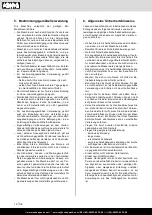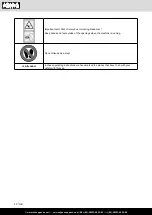
Infeed of material to be chopped
Always switch on the motor first!
•
We recommend: Wear work gloves, goggles and
ear protection.
•
Watch for stones and earth when collecting the ma
-
terial.
•
Do not put hard objects such as stones, glass, met
-
al parts etc. into your garden shredder.
•
Earth wears the cutting blades down fast and
should therefore be removed from the material.
•
Do not put roots with adhering earth into your gar
-
den shredder.
•
Wood such as tree cutting etc. requires sharp
blades and should be shredded separatly to pro
-
long the servicelife of the knives.
•
Feed branches in thick end first and push them
onto the downstroke part of the knife disc if pos-
sible (kickback).
•
Pull the material back forcefully, counteracting the
automatic pull of the machine, in order to avoid kill-
ing the motor when the speed reduces.
•
Freshly cut wood requires less force, so large diam
-
eter cuttings can be shredded easily.
•
Hedge cuttings must be fed in gradually. Some
types tend to jam. Push them in with a long piece
of wood.
•
Shrubs tend to be woody and require sharp blades.
•
Bark is easy to shred when damp. We recommend
gradual shredding.
•
If you want finer shredded results, put the shredded
material back into the shredder a second time.
•
Paper should be shredded damp and rolled up. Re
-
move the metal staples from cardboard boxes.
•
Vegetable waste is normally easy to shred, but may
stick due to moisture.
•
It is best to save some dry material for the final run.
It absorbs the moisture in the machine and cleans
the inside of the housing.
•
Important: Remove remaining waste from the ma
-
chine after finishing work. Caution:
PULL ELEC-
TRIC PLUG
• To start up the machine again after an interruption
of work, the blade housing has to be cleared of
shredded material.
Conduct in case of an accident
Start First Aid measures relevant to the injury and re
-
quest medical help as quickly as possible. Prevent
the injured person from further injury and keep him/
her rested. For potentially occurring accidents, the
First Aid kit, according to DIN 13164, should always
be handy at the work place. Material taken from the
First Aid kit must be replaced immediately. When you
are requesting help, give the following information:
1. Location of accident
2.
Type of accident
3.
Number of injured people
4.
Type of injuries
Electrical safety
•
Design of the connection cable according to IEC
60 245 (H 07 RN-F) with a core cross-section of
at least
- 1.5 mm
2
for cable lengths up to 25 m
- 2.5 mm
2
for cable lengths over 25 m
• Long and thin connection lines result in a potential
drop. The motor does not reach any longer its maxi
-
mal power; the function of the device is reduced.
• Plugs and coupler outlets on connection cables
must be made of rubber, plasticised PVC or other
thermoplastic material of same mechanical stability
or be covered with this material.
• The connector of the connection cable must be
splash-proof.
•
When running the connection line observe that it
does not interfere, is not squeezed, bended and the
plug connection does not get wet.
•
Wind off completely the cable when using a cable
drum.
• Do not use the cable for purposes for which it is
not meant. Protect the cable against heat, oil and
sharp edges. Do not use the cable to pull the plug
from the socket.
•
Regularly check the extension cables and replace
them if they are damaged.
• Do not touch a damaged connection cable before
disconnecting it from the mains. A damaged con-
nection cable may cause contact with live parts.
•
Do not use any defective connection cables.
•
When working outdoors, only use extension cables
especially approved and appropriately labelled for
outdoor use.
•
Do not set up any provisional electrical connec
-
tions.
•
Never bypass protective devices or deactivate
them.
•
Only hook up the machine by means of a fault-cur
-
rent circuit breaker (30 mA).
• The electrical connection or repairs to electrical
parts of the machine must be carried out by a cer
-
tified electrician or one of our customer service
points. Local regulations – especially regarding
protective measures – must be observed.
•
Damaged mains leads must be replaced by the
manufacturer or one of their service workshops or
a similar qualified person to prevent dangers.
•
Repairs to other parts of the machine must be car
-
ried out by the manufacturer or one of his customer
service points. Use only original spare. Accidents
can arise for the user through the use of other
spare parts. The manufacturer is not liable for any
damage or injury resulting from such action.
m
WARNING
! This electric tool generates an elec-
tromagnetic field during operation. This field can im
-
pair active or passive medical implants under certain
conditions. In order to prevent the risk of serious or
deadly injuries, we recommend that persons with
medical implants consult with their physician and the
manufacturer of the medical implant prior to operat-
ing the electric tool.
www.scheppach.com /
+(49)-08223-4002-99 /
+(49)-08223-4002-58
GB
| 25
Summary of Contents for 5904410901
Page 2: ... www scheppach com service scheppach com 49 08223 4002 99 49 08223 4002 58 2 ...
Page 6: ...5 5 7 6 2 www scheppach com service scheppach com 49 08223 4002 99 49 08223 4002 58 6 ...
Page 7: ...7 7a 7c 7d 7b www scheppach com service scheppach com 49 08223 4002 99 49 08223 4002 58 7 ...
Page 119: ... www scheppach com service scheppach com 49 08223 4002 99 49 08223 4002 58 119 ...
Page 120: ... www scheppach com service scheppach com 49 08223 4002 99 49 08223 4002 58 120 ...
Page 122: ... www scheppach com service scheppach com 49 08223 4002 99 49 08223 4002 58 122 ...
















































